A $1.6-billion LNG project will go ahead at the Woodfibre site in Howe Sound, company officials and B.C. Premier Christy Clark announced Friday.
“This project is a go,” said Byng Giraud, vice-president of corporate affairs for Woodfibre LNG Ltd, before a hard-hat wearing crowd of guests and media at the project site across from Squamish. Giraud said the parent company of Woodfibre, Pacific Oil and Gas Ltd., has given approval to build the LNG plant.
Clark called the decision to go ahead with the plant “one of the largest private-sector investments ever made in the Lower Mainland” and said it would provide “good, environmentally sustainable high-paying jobs” while fighting global climate change.
The project is expected to create 650 construction jobs during a two-year building phase and about 100 jobs over 25 years once the plant is operational.
Woodfibre is the first LNG project to announce it plans to go ahead.
“LNG in B.C. is finally becoming a reality,” said Clark, who has faced criticism after promising LNG would provide an economic boom for the province that has so far failed to materialize.
A key part of the decision to go ahead with the Woodfibre project is tied to the province granting the project a cheaper industrial rate for electricity from BC Hydro to power its liquefaction process. The rate means Woodfibre will be able to buy electricity for about $60 per megawatt hour instead of the previously announced rate of $84 per MW hour, Giraud confirmed.
Powering its liquefaction through electricity rather than gas will lower the amount of greenhouse gas emitted by the project. “By using electricity instead of gas, Woodfibre will avoid 350,000 tonnes of GHG emissions a year,” said Clark.
Giraud said the company hopes to have an engineering, procurement and construction contract in place by mid-2017 and a certificate from the B.C. Oil and Gas Commission approved six months after that. If the company follows that timeline, the plant could start shipping LNG by 2020.
But there are still hurdles to cross before that happens.
The company has still not signed sales agreements with overseas customers, Giraud acknowledged. “Stay tuned,” he said on Friday.
Both Woodfibre and the province also have yet to conclude agreements with the Squamish Nation, on whose traditional territory the plant is located.
Chief Ian Campbell of the Squamish Nation chose not attend the announcement on Friday because those agreements have not been concluded.
Recently, Woodfibre agreed to address one of the key environmental concerns about the project by ditching seawater cooling in favour of an air cooling system. But there are still big issues to work out, including an “impacts and benefits agreement” between Woodfibre and the Squamish Nation. That deal is expected to involve agreements on jobs, training, contracting for Squamish Nation companies, and revenue sharing.
Campbell said the province must also reach a deal with the Squamish before it can grant the company rights to go ahead with the project in the area subject to the nation’s aboriginal rights and title.
Campbell said the Squamish Nation has identified some land it has an interest in “whether it be for commercial, market housing or cultural and spiritual purposes.”
Other issues still to be worked out include the location of a FortisBC compressor station, emergency response planning and marine use of Howe Sound.
Woodfibre cannot start building the plant until those agreements are concluded, said Campbell.
Not everyone was cheering the announcement.
Eoin Finn, from the group My Sea to Sky, which is opposed to the project, said Friday the only reason the project is economically viable is that the province is giving Woodfibre cheap electrical power. “That amounts to a rather large giveaway,” he said. “It has all the air of a political decision rather than an economic one. The taxpayers of B.C. and the ratepayers of BC Hydro are going to pay through the nose for this.”
Even using electrical power, the project will generate large amounts of greenhouse gas, he said, which will make it difficult for B.C. to meet its greenhouse gas reduction targets.
Finn said it was “not coincidence” the announcement was made on the eve of the B.C. Liberals’ weekend political convention. “We oppose this and will continue to oppose it,” he said.



